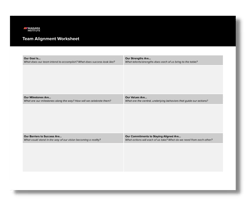5 min read
7 Ways To Improve a Cross-Functional Team
The most tumultuous team I’ve ever been a member of was a cross-functional team. The team was made up of highly-educated, intelligent individuals who...
4 min read
 Michelle Bennett
:
Nov 22, 2022 6:00:00 AM
Michelle Bennett
:
Nov 22, 2022 6:00:00 AM

Most agree that a pillar of organizational success is the integration of functions where individuals come together to solve problems, innovate, and achieve corporate objectives. Yet, the reality in many workplaces looks very different, as it has been found that roughly 75% of cross-functional teams are dysfunctional.
Individuals and leaders set out with the best intentions to build cross-functional relationships, but over time, their expectations of collaboration with peers in other functions warp and change. This blog explores what cross-functional collaboration is, where it breaks down, and what you can do to fix it.
Cross-functional collaboration is when individuals from different functions or departments work together to complete a project or achieve a goal. Cross-functional collaboration can appear in several ways, such as a team of individuals from different departments coming together to solve a company challenge or as part of a company’s culture where individuals behave in a way that supports cross-functional collaboration.
As mentioned, cross-functional relationships and collaboration are something leaders should embrace; however, many professionals find themselves in a reality where work relationships and cooperation between departments have broken down. Here are three common workplace scenarios you may have witnessed where the expectation for cross-functional collaboration does not match reality.
Expectation: Everyone appreciates that by working together, they can achieve more
Reality: A lack of trust between departments spurs negative behaviors such as hoarding resources and information
Trust, communication, and cooperation are essential for cross-functional collaboration to thrive. However, many departments have an us vs. them mentality, where silos are created. When departments become working in silos, the hope of cross-functional collaboration is gone, as they begin to withhold resources and information from each other for various reasons, such as fear, lack of trust, or power struggles between leaders.
Expectation: Everyone is open to new ideas and change if it makes the company stronger
Reality: Ideas and change suggested by other departments is dismissed
With the best intentions, a suggestion is made about how something could be improved in another department. However, instead of the idea being appreciated and explored, it is almost automatically shot down. Fear arises that if the idea is pursued, it will give off the optics that there is a gap in the leader’s abilities or team competence. Due to this poor experience, individuals avoid raising suggestions as they would rather preserve harmony with their peers in another department than provide fresh insights.
Expectation: We’re all working towards the same goal
Reality: Disjointed or conflicting goals, differing priorities and initiatives, and bonus structures
Misaligned goals, priorities, and bonuses are common pitfall that impedes cross-functional collaboration from thriving. Sure, in theory, all departments are working towards corporate objectives; however, when you move down to a functional level, leaders have their own set of objectives and priorities, which also may be tied to a financial incentive.
In business, two teams that should be working together seamlessly but are often out of step and in conflict are marketing and sales, and misaligned goals at a department or team level may be to fault.
For example, marketing is often mandated with objectives such as brand awareness and generating leads, whereas sales teams focus on revenue. With marketing generating as many leads as possible, sales complain the leads are of poor quality. Conversely, marketing complains sales are not following up with the leads as they’re focused on closing revenue. All in all, this could be avoided with aligned goals and priorities that promote collaboration between functions.
Often, the best way to learn how to improve cross-functional collaboration is to explore where it goes wrong. Leadership guru, Patrick Lencioni, wrote a book investing where teams go wrong called The Five Dysfunctions of a Team. In this book, he explains how a lack of trust, a fear of conflict, insufficient commitment, absence of accountability, and inattention to results is where collaboration breaks down.
Leaders must address these dysfunctions by taking steps to create an environment where cross-collaboration thrives. Here’s how you can do that.
.png?width=1920&name=How%20To%20Improve%20Cross-Functional%20Collaboration%20(1).png)
Relationships form when individuals form connections with their peers in other departments, and trust is built over time. Creating opportunities for individuals to connect, such as team-building events, mentoring programs, peer buddies, and stretch assignments in new departments, are ways to form relationships outside of departments.
In addition, employees get their cues on how to behave from their leaders. Therefore, leaders need to lead by example and model the behaviors they want to see. They do so by forming solid relationships with peers in other functions, tapping into their expertise, working together to solve problems, and demonstrating trust.
As mentioned, cross-collaboration often breaks down when individuals want to preserve harmony between departments, and to do so, they avoid discussing new ideas or changes. But for cross-collaboration to happen, leaders must be open-minded and appreciate that they don’t have all the answers and that great ideas can come from anywhere in the organization.
To uncover how open you are to new ideas, Sigma Assessments compiled five questions to ask yourself.
Working with a professional coach is an ideal solution if you find yourself lacking in this area. They can help you uncover your blind spots, work through challenges with change, and help you build the skills and confidence you need to be more open to new ideas.
Showing leaders not only support cross-functional collaboration but also require it of their people is critical to success. This is because the direct leader of an employee has the most significant influence over their behaviors, commitments, and accountabilities. They’re the ones that get their teams to buy into the benefits of collaboration and are also the ones that can hold their people accountable for making it happen.
However, leaders must be skilled to be able to do so. Therefore, an ideal option is to pursue training that gains the competencies to get commitment from employees and secure their agreement to deliver their accountabilities. The Niagara Insitute has created A Leader’s Guide to Accountability in the Workplace to explore the topic further.

When functional leaders have goals and priorities that are not aligned with their peers, it erodes their focus on the big picture and eliminates the need to act and collaborate cross-functionally. Therefore, leaders need to be aligned with their peers so that everyone is focused on a common goal and the collective success of the organization.
To begin the process, use the team alignment worksheet with your peers in other departments to set your goals, uncover your collective strengths, create milestones, establish your values, and secure commitment to stay connected and aligned.
.png)
5 min read
The most tumultuous team I’ve ever been a member of was a cross-functional team. The team was made up of highly-educated, intelligent individuals who...
.png)
6 min read
Every team needs a leader, whether it’s accompanied by a formal title or not. That’s because, without it, collaboration and teamwork are left to...

6 min read
You don’t have to go too far to find examples of the importance of teamwork. From sports teams that have a legacy of winning, to the scientists that...